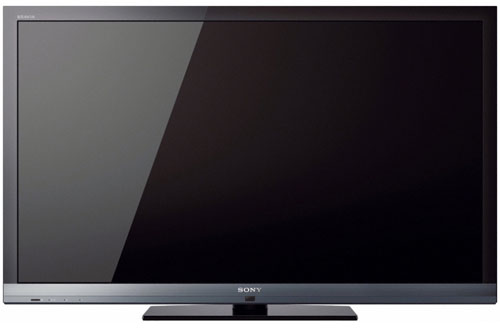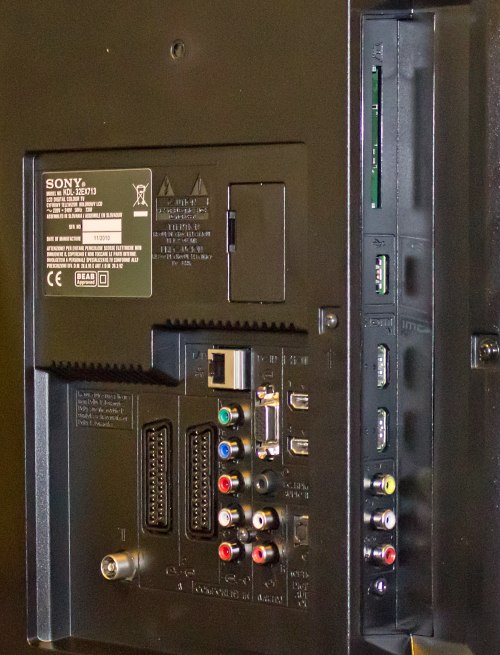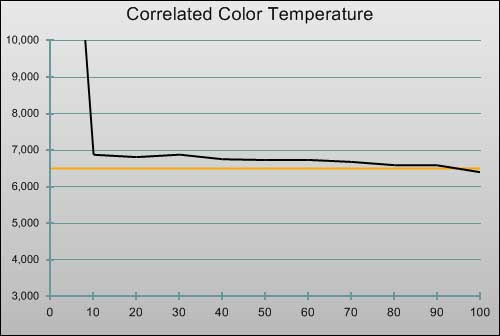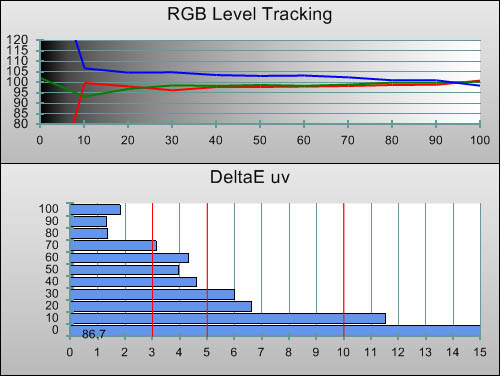“LED TV” (or more descriptively, “LED LCD TV”) is the current trend from most flat-panel TV manufacturers. While video enthusiasts are irritated, sometimes outraged, by what they perceive to be a misleadingly named and superficially motivated product, it seems that a decent amount of consumers are happy to pay up for thinner, sleeker LCD TVs, even if the picture quality is not at quite the same level as their older back-lit sets.
<!-- google_ad_client = 'pub-2887677957235196'; google_ad_slot = '4990177225'; google_ad_width = 336; google_ad_height = 280; //-->
The Sony KDL32EX713 is one such LED-based LCD HDTV, and to give the Japanese TV maker credit where due, they have chosen to promote what’s arguably the most credible advantage of LED-lit LCD: the superior energy efficiency. And certainly, the KDL32EX713 does have its fair share of “green credentials” to boast about: not only do the LEDs which illuminate the screen use less power than traditional CCFL backlighting tubes (and less still than Plasma display panels), but the television is also equipped with Sony’s “Presence Sensor”, which will turn the LCD display and the associated light sources off if it detects that nobody is present in the room.
On top of this, the Sony KDL-32EX713 features everything you’d expect from a modern mid-range HDTV: 1920×1080 panel resolution, support for the DVB-T2 standard (meaning that it can receive Freeview HD channels), and internet connectivity. Sony’s Motionflow 100hz system is also on board to fight the age-old problem of LCD motion blur. Let’s see if all of this comes together to make the Sony KDL32EX713 a respectable 32-inch HDTV.
Note: The specific model we tested was the Sony KDL32EX713U, denoting the 3-pin-plug United Kingdom version. Retailers like Comet, Currys and John Lewis, and etailers such as Dixons and Amazon may sell the LED LCD TV as KDL32EX713, KDL-32EX713 or KDL32EX713U, and we may use these terms interchangeably within this review to refer to the same model. While we did not review the larger 40-inch Sony KDL40EX713/ KDL-40EX713/ KDL40EX713U, there shouldn’t be any significant difference in picture performance given essentially similar specifications.
It’s nice to see that, in spite of the well-publicised cost-cutting that Sony has been undertaking lately, the company can still produce a distinctive looking product. The KDL32EX713 does a good job of separating itself from the many other 32″ displays on the market with a dark silver strip placed below the panel. The Presence Sensor sits below the prominent SONY logo, and a sleek green “power” LED is situated to the bottom-left. The other three corners surrounding the panel are in the gloss black style, and are small enough so as not to dwarf the panel itself.

Despite being an LED side-lit display, the Sony KDL32EX713U is not as outrageously thin as the LED LCD sets from Samsung. In fact, were it not for the previously mentioned energy savings, we would question the point of it using LEDs at all. At its thinnest point, the KDL-32EX713 is about 2.5cm deep, with the depth roughly doubling at its thickest.
The Sony KDL32EX713 features a total of 4 HDMI inputs, and also a single set of analogue Component inputs for HD connectivity. Two of the HDMI inputs are on the TV’s back panel (oddly, inputs 1 and 4), and the remaining inputs (2 and 3) are on the recessed side panel. There are also 2 SCART terminals for older standard definition devices, a PC VGA input, Composite video and stereo audio inputs (does anyone use these?), an RF aerial input for feeding the Digital/Analogue terrestrial tuner, and a LAN connection for connecting the TV to network/internet services.
 |
| Rear & Side: 4 x HDMI, VGA, Component, 2 x Scart, aerial, ethernet & audio outs |
As usual for modern Sony HDTVs, the Xross Media Bar (XMB) menu makes another appearance on the KDL-32EX713. We’re not convinced of the benefits of this menu structure over traditional menus, but we suppose it’s a harmless enough way for Sony to differentiate their product.
![[Picture] menu](https://www.hdtvtest.co.uk/news/wp-content/uploads/2018/04/hdtv_Sony-KDL32EX713_picture.jpg) | ![[White Balance] menu](https://www.hdtvtest.co.uk/news/wp-content/uploads/2018/04/hdtv_Sony-KDL32EX713_wb.jpg) |
| [Picture] menu | [White Balance] menu |
Most of the settings of interest to us are housed in the [Display] > [Picture] menu. Control over basic picture parameters is given, and the user is also allowed to engage an analogue-centric, motion-smoothing [Noise Reduction] control, as well as an [MPEG Noise Reduction] system which attempts to blur out the unwanted “mosaic” artefacting that’s become a sad fact of life for Digital TV transmissions. Sony’s [Motionflow] system can be switched Off entirely, or set to “Standard” and “High” levels. Drilling down another level, Sony has a selection of largely superfluous [Advanced Settings]. Out of these, we’re interested in the [White Balance] adjustment (which should allow us to fine-tune the TV’s Greyscale tracking and minimise any colour tinting that the picture may have) and the [Gamma] control, both of which we’ll investigate during the Calibration section.
The [Display] > [Screen] menu is also of interest, since it allows us to configure how 4:3 material is shown on the 16:9 widescreen panel. By default, the TV applies non-linear stretching to adapt the picture to the screen (“Smart”), whereas video purists will prefer to see the original picture with side-bars (“4:3”). It’s also worth adjusting the [Display Area] option to “+1” for standard definition content, to lessen the amount of overscan and see more of the image.
Note: Our Sony KDL-32EX713 review sample was calibrated using Calman Professional, the industry-leading video calibration software.
When we first turned on our Sony KDL32EX713 review sample, it was producing a very blue-tinted, artificial looking, sharpened picture, as is typical of almost all consumer TVs. From experience, we knew to press the [SCENE] button on the remote control and to select [Cinema]. This resulted in a much more natural picture, without the unwanted blue tinting, and represents the best picture the Sony KDL32EX713U can give without any further adjustment. When we say the “best picture”, we mean the one that has maximum detail and has the truest, most life-like colours.
Sony’s thinking, apparently, is that films most of all deserve accurate reproduction, whereas other types of video can be displayed with off-kilter colour and a more processed look – hence the inclusion of the [SCENE] remote control button, which invites users to select a different picture mode depending on the type of programme they are watching. This doesn’t make any sense, because it is the lighting technicians, colourists, directors, and other industry professionals who define the look of their programmes, within the already established HDTV (and SD TV) standards for Colour and White Point. For this reason, we select [Cinema] and leave the Sony KDL32EX713 in this mode permanently – except for when playing video games, for reasons we’ll discuss in the “Console Gaming” section later.
After enabling the [Cinema] mode, we took a series of measurements from the KDL-32EX713’s screen, to see how adept it was at correctly colouring Grey shades, which is the starting point of high picture quality. A good quality display will not only get the colour of Grey suitably close to correct, but it will be able to do so equally well in the darkest (left of RGB Tracking chart) and brightest (right of RGB Tracking chart) areas of the picture.
 |
| Pre-calibration CCT in [Cinema] mode |
 |
| Pre-calibration RGB tracking and delta errors (dEs) |
As we suspected, our individual Sony KDL32EX713U review sample was displaying images with a very slight excess of blue (although the excess blue was nowhere near as bad as it was before we selected “CINEMA”). We had noticed that flesh tones looked a little frosty, but this is probably a result of the great lengths of time we spend watching perfectly calibrated displays – most people would not notice an issue. Of course, it’s an inaccuracy in the picture all the same, so, with the aid of a reference colorimeter, we set to work measuring and adjusting the [White Balance] controls to get the most neutral whites possible:
![Post-calibration CCT in [Cinema] mode](https://www.hdtvtest.co.uk/news/wp-content/uploads/2018/04/hdtv_Sony-KDL32EX713_post-cct.jpg) |
| Post-calibration CCT in [Cinema] mode |
![Post-calibration RGB Tracking in [Cinema] mode](https://www.hdtvtest.co.uk/news/wp-content/uploads/2018/04/hdtv_Sony-KDL32EX713_post-rgb.jpg) |
| Post-calibration RGB tracking and dEs in [Cinema] mode |
After calibration, Greyscale tracking was of a good standard. In fact, from 20-100% stimulus, it was nearly perfect. As usual with Sony’s LCD displays, an excess of blue at 10% stimulus hangs around in the shadows, and taints an otherwise good performance. We tried to balance the error as best we could during the calibration process, but this simply created unacceptable spikes elsewhere in the Greyscale range, so the frostiness at 10% had to remain as the lesser evil. The picture quality was still good, but Sony should take a look at competing displays from Samsung, and especially LG. These two companies have been avoiding issues like this by equipping their TVs with 10-point White Balance controls, which allows each stimulus level (10, 20, 30 and so on) to be adjusted individually. Had Sony included such a system instead of their basic 2-point control, Greyscale tracking on the KDL32EX713 could perhaps have been perfect.
![Gamma curve in [Cinema] mode](https://www.hdtvtest.co.uk/news/wp-content/uploads/2018/04/hdtv_Sony-KDL32EX713_post-gamma.jpg) | |
| Gamma curve in [Cinema] mode | Corresponding gamma tracking |
Lastly, Gamma. Gamma describes the amount of light output by the television relative to the luminance level of the video signal being sent to it. Here, the Sony KDL-32EX713 did a very good job. The amount of lightness at each stimulus level was just about correct, without any missing shadow or highlight details. We did have to set the [Gamma] control to -1 on our review sample to gain this effect, however: the default Gamma left the picture with a slight lack of overall richness. One warning to calibrators: the [Brightness] setting on the Sony KDL32EX713U will usually need adjusted after Greyscale calibration, meaning that checking back and forth between a Black Level test pattern during Greyscale calibration is advisable.
Sony’s flat-screen HDTVs still do not include proper Colour Management controls – there is a gimmicky option called [Live Colour] which adds Luminance and Hue errors into the image (um…yay?), but no real in-depth colour controls. Fortunately, this is not really a problem on the KDL32EX713, because the colour performance we witnessed by eye and measured using our colorimeter was highly serviceable.
![Post-calibration CIE chart in [Cinema] mode](https://www.hdtvtest.co.uk/news/wp-content/uploads/2018/04/hdtv_Sony-KDL32EX713_post-cie.jpg) |
| Post-calibration CIE chart with reference to HD Rec.709 |
As is the case with many of the LED side-lit LCD displays we’ve calibrated and measured at HDTVTest, we noticed that the Sony KDL-32EX713 couldn’t fully saturate Red and Blue. These saturation errors were by no means blatant; users would likely have to compare side-by-side with a perfectly accurate display to become annoyed by them. More importantly, there were no colour decoding (a.k.a. colour luminance) errors worth worrying about, which would have been a much bigger problem.
![Post-calibration Luminance levels in [Cinema] mode](https://www.hdtvtest.co.uk/news/wp-content/uploads/2018/04/hdtv_Sony-KDL32EX713_post-colour-lum.jpg) |
| Post-calibration colour luminance (coloured bars = targets; black bars = measured values) |
| Dead pixels | One black spot in centre-right |
| Screen uniformity | Visible darker “columns” – no colour tinting |
| Overscanning on HDMI | 0% by default, or with [Display Area] set to “Full Pixel” |
| Blacker than black | Passed |
| Calibrated black level | 0.09 cd/m2 |
| Black level retention | Stable with [Advanced Contrast Enhancer] off, except for 9+ seconds of black |
| Primary chromaticity | Very Good |
| Scaling | Good |
| Video mode deinterlacing | Below average, jaggies visible on HQV test sequence |
| Film mode deinterlacing | Excellent – passed 2:2 PAL test with [Film Mode] on |
| Viewing angle | Noticeable loss of colour when viewed off-centre |
| Motion resolution | 550-600 lines with [Motionflow], 300 without |
| Digital noise reduction | Good: Optional, not forced |
| Sharpness | Defeatable edge enhancement |
| Luma/Chroma bandwidth (Blu-ray) | Full Luma, slightly blurred Chroma except in [Game] mode |
| 1080p/24 capability | Accepts 1080p/24 video signal; no telecine judder |
| Input lag | 31ms slower than a lag-free CRT |
| Full 4:4:4 reproduction | Yes, in “Game” mode |
| Default [Normal] mode | 49 watts |
| Calibrated [Cinema] mode | 49 watts |
| Standby | 1 watt |
By default, the Sony KDL32EX713U senses the ambient light in the viewing environment and adjusts the LED light intensity accordingly. As such, power consumption varies depending on the room environment when this setting is on.
The Sony KDL32EX713 appears to be using a Samsung SPVA MVA panel rather than one of Sharp’s UV2A type (which some newer Sony LCD TVs have been using recently). Both of these panel types have a track record of providing good contrast performance, but the inclusion of LED light sources tends to result in brighter blacks that are not as consistently dark across the entire screen. After confirming that the [Backlight] setting was set to give a peak light output of 130 cd/m2, we measured the KDL32EX713’s black level as being 0.09 cd/m2. Although this isn’t terrible, it’s the least inspiring result we’ve seen from a Sony display recently and wasn’t as good as what we were expecting from a display in this price range. That, of course, is the problem with LED LCD displays – you are currently paying for style (and eco-friendliness!) over image quality.
The Sony KDL32EX713U does use auto-dimming (where the TV will cut the light output to the screen if the LCD panel is showing a dark picture), but it’s not to produce superficially blacker blacks – it’s implemented in a way that isn’t objectionable, and seems to have been added to save power, which makes total sense. After 9 seconds of a completely black video signal, the LCD television will dim its LEDs down to an almost fully-off state. After a further 20 seconds, it will turn them off entirely, producing a complete absence of light on screen – or in other words, true black. Auto-dimming is often annoying on other manufacturers’ TVs, but Sony’s never gets in the way of actual content: we can’t think of any films off-hand that feature more than 9 seconds of complete black. Compare this to Samsung’s LED LCD TVs, which rapidly dim the on-screen picture if the scene becomes just slightly dark!
It might just be because the last couple of displays we’ve reviewed have been Plasmas and also IPS LCDs (renowned for their better-than-average performance in this area), but the Sony KDL32EX713U’s off-axis viewing angle performance seems a little troublesome. The biggest problem is just how quickly the picture loses its saturation if the user moves even slightly off-centre. Black levels remain more consistent than you would expect (although they still do lighten, and turn more of a purpley-blue), but colours quickly become pale and unconvincing. Whites also turn grey when viewed from the sides.
It’s quite hard to recommend final purchasing decisions based on this factor. A narrow viewing angle simply doesn’t bother some people, who have no problem with always sitting dead-centre whilst watching to get the best picture quality. On the other hand, it can be a major contributing factor for others. The sad truth is that no LCD-based TV excels in this area, and the ones that do (which feature IPS panels) suffer in other areas, such as black level/contrast performance. We imagine LCD buyers are used to viewing angle limitations by now, so can only advise giving the KDL-32EX713 a demo if in doubt.
Based on previous experience of 100hz LCD TVs, we had a decent idea of how many lines of resolution the Sony KDL32EX713 would manage to keep distinct during the scrolling motion tests. We then confirmed the situation with the FPD Benchmark Software test disc. With [Motionflow] enabled, it managed to display around 550-600 lines, albeit with some flickering, and unusually, small purpley-blue streaks in the chart. Disabling [Motionflow] produced just 300 lines of resolution, which is standard for an LCD running without motion-compensated frame interpolation (MCFI).
550-600 lines is enough to display high-motion video material (sporting events, shows like Strictly Come Dancing, etc.) with a good level of clarity. For general TV viewing, we definitely recommend leaving the [Motionflow] system enabled (on either the Standard or High settings).
The KDL32EX713’s performance with standard definition was entirely predictable and consistent with other recent Sony LCDs. It did a decent, but not outstanding job of concealing jaggedness in standard 576i (European Digital TV and non-upscaled DVD) material, and did a great job of presenting Film material stored inside an SD video signal at full quality, effortlessly locking onto the PAL 2-2 film cadence in our tests (provided the [Film Mode] option was not turned Off in the menu).
Scaling of the SD image to the HD panel didn’t look as brilliantly crisp as it does on dedicated HQV video processors or Panasonic’s 2010 displays (both of which feature incredibly clean, crisp image resizing), but it was still presenting enough detail from the source without any obvious ringing/halos. For a smaller display, this SD performance is definitely acceptable, but it’s not top of the range.
Good news: so long as any noise reduction, sharpening, colour exaggerating, or otherwise revisionist processing was shut off, the Sony KDL32EX713U displayed HD video signals unadulterated, without any attempts at “enhancing” the picture. There were no nasty surprises such as unwanted film grain blurring (we’re looking at you, Samsung!), and no unwanted sharpening or smoothing (ahem, LG). To borrow a phrase from the Imaging Science Foundation, once the KDL-32EX713 had been correctly set up, it (generally) showed the right picture, the whole picture, and nothing but the picture.
As a result, the image quality was largely determined by inevitable factors – that is, the ones imposed by hardware, such as the LCD panel and its components. From a face-on sitting position, the image quality was excellent, although there was sometimes a little bit of panel non-uniformity visible, in the form of darkened corners.
Sony’s [Film Mode] option is worth discussing in the context of HD Blu-ray movies, since it differs from most manufacturer’s implementations – particularly with regard to how it interacts with the 100hz Motionflow system. Since we’re interested in watching films as intended by their directors, we have a vested interest in avoiding the so-called “soap opera effect”, a phrase coined by users to describe the unnatural video camera-like movement that 100hz/200hz processing systems sometimes impose on low-motion film content. On the Sony KDL32EX713, we set the [Motionflow] system to its “Standard” setting, and set [Film Mode] to “Auto2”. “Auto2” instructs the TV to preserve the look of 24fps film material and not introduce the “sped up” motion (the “Auto1” setting allows motion to become video-like). In this mode, the TV also managed to display 24fps material without any judder.
When we had a look at Ponyo (one of our preferred 2D animation demo discs) under this setup, we did notice very small motion corruption, particularly on the panning shots near the beginning of the film, which showed small misplaced blocks. Synthetic content, especially hand-drawn animation, generally shows motion interpolation errors very effectively, so we weren’t surprised to see some motion errors which would probably have gone totally unnoticed with live action material. This was very subtle, and shutting [Motionflow] “Off” cured the issue. As usual, Sony have done a good job of keeping control over this factor in the hands of the user. We did also choose to shut off the [Advanced Contrast Enhancer], which attempts to regulate LED intensity relative to the light content of the video signal. While this processing is a well intentioned attempt at compensating for LCD’s contrast limitations, we found it to be distracting in practice.
Thankfully, the Sony KDL32EX713’s mostly accurate colour presented the film in a pleasing way. None of the colours ever appeared garish or sickly-looking as they do on HD TV displays with exaggerated colour gamuts. This allowed both animated and live action content to play back with a very natural look.
We were glad to see that, by default, the KDL32EX713U was not overscanning (cropping the edges) of 1080p HD Blu-ray movies. Most other TV manufacturers still require the user to manually turn this now-questionable feature off, but Sony has taken the initiative and confined overscanning to the history books where it belongs (it can still be enabled, should there be some reason for doing so). One note, though: if you’re watching HDTV via the built-in Freeview HD tuner, overscan is still turned on by default. We entered the [Screen] menu and set [Display Area] (Sony’s non-technical name for Overscan) to “Full Pixel” for 1080i HDTV channels on Freeview HD. We never saw any problems arising as a result of this choice.
We gave Halo: Reach a spin on the Sony KDL32EX713, and were quite happy with the gaming performance. So long as we pressed the [SCENE] button and selected the lag-reducing “Game” mode, we found that the KDL-32EX713 was lagging by 31ms, meaning that the game felt just a tiny bit less responsive than on the fastest displays and was generally enjoyable.
Naturally, the [Game] mode cuts out laggy processing such as [Motionflow] (which has to analyse motion across a series of frames, thus inevitably adding delay by its very design). This means that, like on every other LCD TV, the most responsive, fluid gaming experience can only be had if you forego the higher motion resolution that 100hz can bring. This is still a worthwhile trade-off, because input lag can make many gaming experiences more frustrating than fun: a little bit of LCD motion blur is a small price to pay to be rid of it.
Sony were right to give the KDL32EX713’s energy efficiency top billing, because this is one of its biggest strengths. That’s not to say that its picture quality is bad – although the viewing angle performance will be troublesome in larger, wider viewing environments, the TV manages to produce a fairly satisfying picture if the user will just comply with the LCD rule of sitting face-on. Greyscale linearity is good, meaning that the picture is largely free of unwanted colour tints, although the KDL32EX713U does exhibit the common Sony LCD problem of blue-tinted shadows, so there’s still room for improvement. Colour and gamma performance are both very good. Black level performance is a little disappointing, with the Sony KDL32EX713’s rendition of deep black instead being a purpley-blue glow.
All of these attributes combine to produce a satisfyingly realistic picture from an LED-based LCD TV which is good, but slightly overpriced, in this writer’s opinion. With this said, we can’t think of any obviously better 32″ LED TV displays right now, either. If you want to watch your energy bills and still watch a good quality display, the Sony KDL32EX713 definitely deserves a look.
